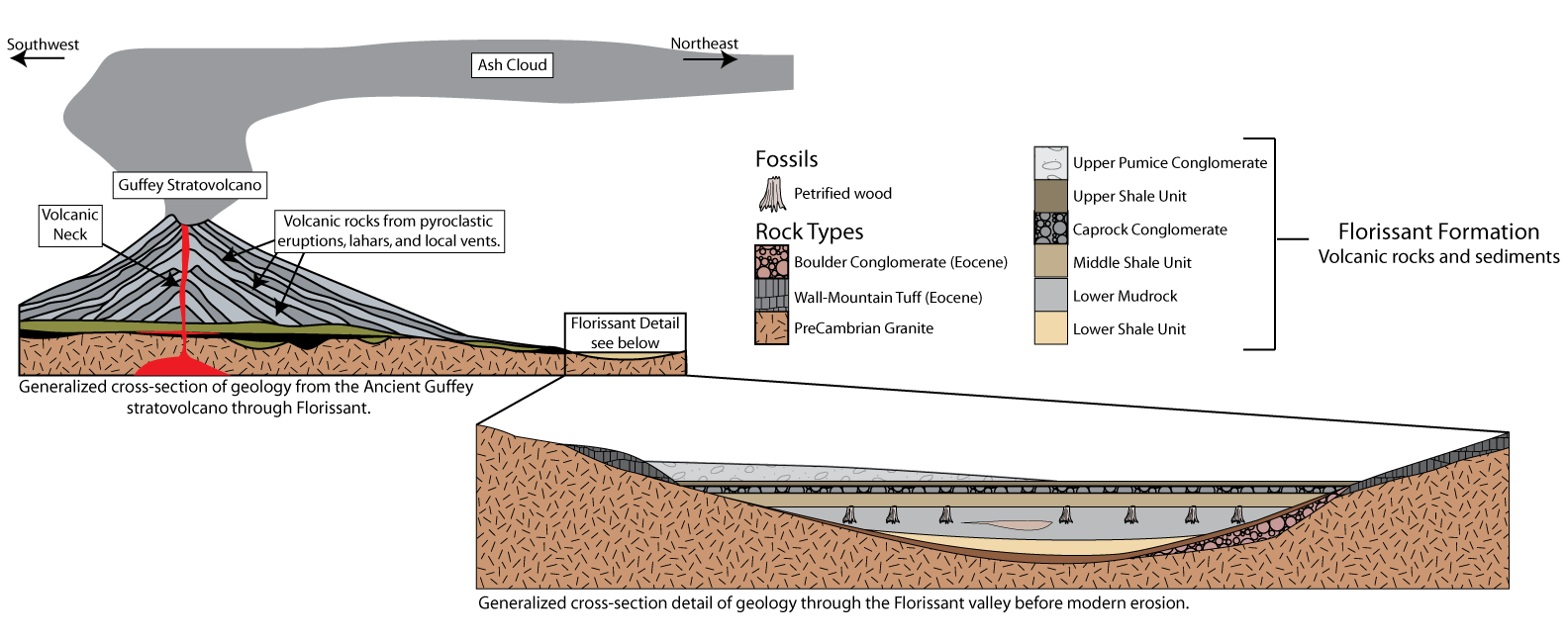|
To see the renmants of the geologic history described below, hike the Geologic Trail, a 1 mile walk one-way from the Visitor Center.

Pikes Peak Granite The oldest granite in the Pikes Peak area is the Cripple Creek Granite (1.46 billion years old), whereas the Pikes Peak Granite is approximately 1.08 billion years old (Wobus, 2001). Most of the large outcrops of granular fragments and boulders that are colored reddish-orange in the Florissant area are Pikes Peak Granite. Wall Mountain Tuff During the uplift of the ancestral Rocky Mountains during the late Paleozoic, most sediment deposited before that time was eroded. This formed deep valleys that by the Late Eocene allowed volcanic debris and sediments to be deposited. It was into these deep valleys that the Wall Mountain Tuff was deposited. The Wall Mountain Tuff was formed as the result of an enormous pyroclastic flow from a caldera near Mount Princeton, 50 miles west of Florissant around 37 million years ago. The landscape of the Florissant area was absolutely devastated following the eruption of the Wall Mountain Tuff. Eocene Boulder Conglomerate Prior to the eruption of Wall Mountain Tuff, some valleys in the region were filled with eroded rocks and debris, named the Echo Park Alluvium, basically debris from the surrounding mountains. Over 2 million years passed between the deposition of the Wall Mountain Tuff and deposition of the volcanic material into the ancient lake at Florissant. In that time, much of the Wall Mountain Tuff was eroded away, leaving only scattered hints of its once immense lateral expanse. In place of the Wall Mountain Tuff, filling the valleys and draping over the landscape once occupied by the tuff, was deposited the Tallahassee Creek Conglomerate. The Guffey Volcanic Complex The town of Guffey, CO sits almost in the center of what we refer to as the Guffey Volcanic Center, a series of volcanoes within the Guffey area. These eruptive events (Figure 1) provided the volcanic material that helped create the ancient lakes at Florissant (Figure 2), as well as aiding in the preservation of fossils. The Florissant Formation Lahars from the Guffey Volcanic Center flowed swiftly down the mountains and into the valley that was Florissant. A stream flowing through the Florissant valley was dammed by one of these lahars, forming the first of three lakes into which the lower shale unit was deposited. Gradually, the lake filled with shale and ash from ongoing volcanic eruptions to the point where the lake almost disappeared and all that was left was a series of small streams cutting through a valley into which the sediments of the lower mudstone unit were deposited. It was at this time that the giant redwoods and other trees grew, only to be buried by a volcanic mudflow. Following the burial of the trees, a second lahar flowed down the valley to the south of Florissant and created a dam which created another lake and allowed the sediments of the middle shale to be deposited. The middle shale unit is the primary shale unit visitors see when coming to Florissant. Following a relatively quiet period of gradual lake sediment deposition, a debris flow (caprock conglomerate) filled the much of the lake. Evidence of this conglomerate being deposited into the lake comes in the form of water escape features. Lake shale (upper shale unit) deposition continued in the lake following the conglomerate event. The final unit deposited into the ancient lake, the upper pumice conglomerate, was a result of a large-scale eruption of pumice and ash from the Guffey Volcanic Complex. The Never-ending Story The story of Florissant Fossil Beds doesn't end with the Eocene. Quaternary glaciers capped many of the higher mountains in the area, including the recently uplifted Pikes Peak, but most of the sediments in the Florissant valley of this age are terrace gravels deposited by gravity and water. The paleontologic story does not end with the Eocene either, as a Columbian Mammoth (Mammuthus columbi) was recently found and dated to approximately 49,830 years ago. |
Last updated: August 7, 2021
